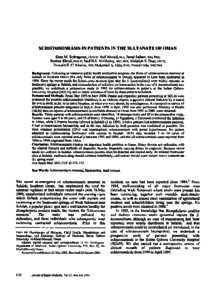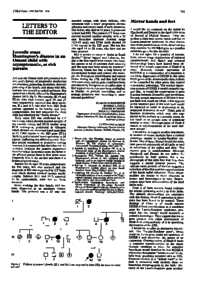وثيقة
Schistosomiasis in patients in the Sultanate of Oman.
المعرف
DOI: 10.5144/0256-4947.2001.170
المصدر
Annals of Saudi Medicine. v. 21, 3-4, p. 170-173
المساهمون
Ahmed, Asif., مؤلف
Sallam, Jamal., مؤلف
Khoul, Roshan., مؤلف
Al-Dhahry, Said H. S., مؤلف
Daar, Abdallah S., مؤلف
El-Khatim, Hussein S., مؤلف
Idris, Mohamed A., مؤلف
Date, Anand., مؤلف
الدولة
Saudi Arabia.
مكان النشر
Riyadh.
الناشر
King Faisal Specialist Hospital and Research Centre.
ميلادي
2001-05-01
اللغة
الأنجليزية
الموضوع
الملخص الإنجليزي
Background: Following an intensive public health eradication program, the focus of schistosomiasis mansoni at Salalah in Southern Oman (the only focus of schistosomiasis in Oman), appeared to have been eradicated in 1994. Since the vector snails for Schistosoma mansoni (and also for S. haematobium) were widely endemic in freshwater springs at Salalah, and reintroduction of infection (or introduction in the case of S. haematobium) was possible, we undertook a prospective study in 1995 for schistosomiasis in patients at the Sultan Qaboos University Hospital (SQUH), and to obtain evidence of visits by these patients to Salalah. Patients and Methods: From May 1995 to May 2000, Omani and expatriate patients presenting at SQUH were evaluated for possible schistosomiasis (residence in an endemic region, suggestive clinical features) by a search for ova in stool, urine, or in tissue biopsies, or when ova were absent, by serodiagnosis. A retrospective survey of schistosomiasis patients diagnosed in SQUH from 1990 to April 1995 was also performed. Ministry of Health (MOH) data on reports of schistosomiasis (a notifiable disease) in Oman from 1991 to 2000, were obtained. Results: Thirty patients with schistosomiasis were identified, 10 retrospectively and 20 in the prospective study. Patients were aged 9 to 60 years, and 25 of them (10 Omanis, 14 Egyptians, 1 Sudanese) contracted the infection in Africa, while 5 Omanis became infected in Salalah (3 in 1999). Twelve patients had schistosomiasis mansoni, 6 had schistosomiasis haematobia, and in the rest, infection by both parasites was confirmed or possible. The most common presentation (23%) was hepatosplenic schistosomiasis with portal hypertension. No patient admitted to contaminating freshwater with excreta in Salalah. MOH data revealed 3 to 14 cases of schistosomiasis were reported annually between 1991 and 2000, and that all schistosomiasis cases reported from 1994 to 1998 originated from Africa. Conclusion: Schistosomiasis remains an important health problem in Oman. Many doctors are unfamiliar with the clinical features and methods of diagnosis, thereby frequently causing delays in diagnosis. Because vector snails are endemic in Salalah, schistosomiasis patients must be detected and treated early. At infested freshwater sites at Salalah, mollusciciding should continue indefinitely, and notices should warn visitors not to contaminate the spring water.
ISSN
0256-4947
قالب العنصر
مقالات الدوريات


